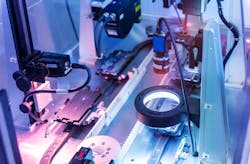Design Phase Planning for Machine Vision Lighting
Automation engineers must carefully manage the expectations and realities of machine vision systems to avoid project delays or failures. Misconceptions about when to integrate vision inspections often lead to infeasible applications.
Engineers should consider the vision system requirements, including light working distance and camera placement, early in the design phase to ensure optimal image capture, partner publication Control Design wrote in a recent article. High-speed machines may require brighter lighting, and ambient light issues should be addressed using faster shutter speeds, bandpass filters or shrouds.
Ensuring adequate space for cameras and the necessary light conditions are crucial for inspecting all sides of a workpiece effectively. Ignoring these factors can result in costly redesigns or systems that do not meet customer expectations.
A common pitfall is scope mismanagement, where engineers either set overly ambitious goals or allow scope creep, complicating the vision system’s requirements. It is unrealistic to expect a single vision system to inspect all samples with perfect accuracy, especially when dealing with large fields of view (FOV) or workpieces with significant variations. Engineers should break down inspection tasks across multiple cameras to reduce complexity and ensure manageable FOVs.
To learn more about machine vision lighting design, read the full article from Control Design.

